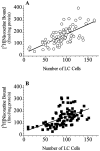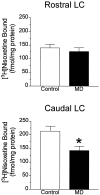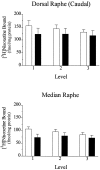Reduced levels of norepinephrine transporters in the locus coeruleus in major depression
- PMID: 9334417
- PMCID: PMC6573768
- DOI: 10.1523/JNEUROSCI.17-21-08451.1997
Reduced levels of norepinephrine transporters in the locus coeruleus in major depression
Abstract
The norepinephrine transporter (NET) is a membrane protein responsible for termination of the action of synaptic norepinephrine and is a site of action of many drugs used to treat major depression. The present study determined whether the binding of [3H]nisoxetine to the NET is altered in the locus coeruleus (LC) in major depression, using brain tissue collected postmortem from subjects diagnosed with major depression and from age-matched normal control subjects. Thirteen of the 15 major depressive subjects studied died by suicide. The distribution of [3H]nisoxetine binding along the rostro-caudal axis of the nucleus was uneven and was paralleled by a similar uneven distribution of neuromelanin-containing cells in both major depressives and psychiatrically normal control subjects. The binding of [3H]nisoxetine to NETs in the midcaudal portion of the LC from major depressive subjects was significantly lower than that from age-matched, normal control subjects. The binding of [3H]nisoxetine to NETs in other regions of the LC was similar in major depressives and control subjects. In contrast to reductions in binding to NETs, there were no significant differences in the number of noradrenergic cells at any particular level of the LC between major depressives and normal control subjects. The decreased binding of [3H]nisoxetine to NETs in the LC in major depression may reflect a compensatory downregulation of this transporter protein in response to an insufficient availability of its substrate (norepinephrine) at the synapse.
Figures






References
-
- Andreasen NC, Endicott J, Spitzer RL, Winokur G. The family history method using diagnostic criteria. Reliability and validity. Arch Gen Psychiatry. 1977;34:1229–1235. - PubMed
-
- Arango V, Underwood MD, Mann JJ. Fewer pigmented neurons in the locus coeruleus of uncomplicated alcoholics. Brain Res. 1994;650:1–8. - PubMed
-
- Arango V, Underwood MD, Mann JJ. Fewer pigmented locus coeruleus neurons in suicide victims: preliminary results. Biol Psychiatry. 1996;39:112–120. - PubMed
-
- Baker KG, Tork I, Hornung JP, Halasz P. The human locus coeruleus complex: an immunohistochemical and three dimensional reconstruction study. Exp Brain Res. 1989;77:257–270. - PubMed
-
- Barker EL, Blakely RD. Norepinephrine and serotonin transporters. Molecular targets of antidepressant drugs. In: Bloom FE, Kupfer DJ, editors. Psychopharmacology. A fourth generation of progress. Raven; New York: 1995. pp. 321–333.
Publication types
MeSH terms
Substances
Grants and funding
LinkOut - more resources
Full Text Sources
Other Literature Sources
